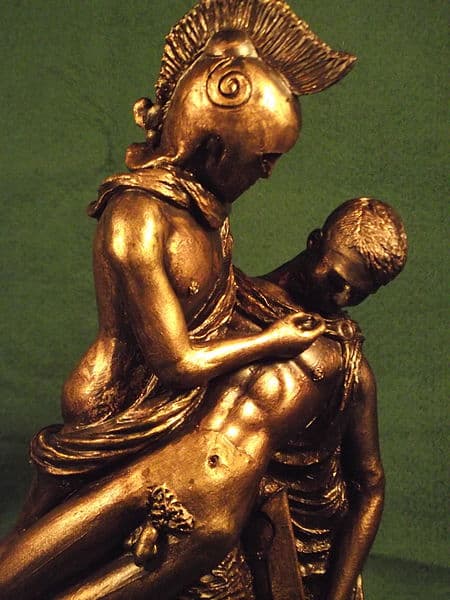In the vast tapestry of Greek mythology, Patroclus stands as a symbol of loyalty, friendship, and tragedy. While not as renowned as Achilles or Hector, his role in the Trojan War and his deep bond with Achilles make him an unforgettable character in the annals of myth.
Patroclus Key Facts
| Parents | Menoetius and unknown mother |
| Partners | Achilles |
| Siblings | None known |
| Offspring | None |
| Other names | Patroklos |
| Roman name | Patroclus |
| Best Known Myth | His death and its impact on Achilles |
Name and Etymology
Patroclus, or “Patroklos” in ancient Greek, derives its roots from the words “pater” meaning “father” and “kleos” meaning “glory.” Essentially, his name signifies “glory of the father.” The Romans, ever the admirers of Greek culture, adopted many of their myths, keeping the name Patroclus intact. Throughout various texts, he’s occasionally referred to by epithets highlighting his bravery and loyalty.
The name’s resonance goes beyond mere phonetics. It’s a reflection of his character, a young warrior who, in many ways, lived up to the glory and expectations set by his lineage. While the Romans had their own pantheon, they often drew parallels with Greek heroes, and in the case of Patroclus, his name and essence remained unchanged.
In the broader spectrum of Greek mythology, names often carried weight, serving as prophecies or descriptors of one’s fate or character. Patroclus, with his name’s emphasis on paternal glory, was no exception, and his actions in the myths echo this sentiment.
Patroclus’ Family and Relationships
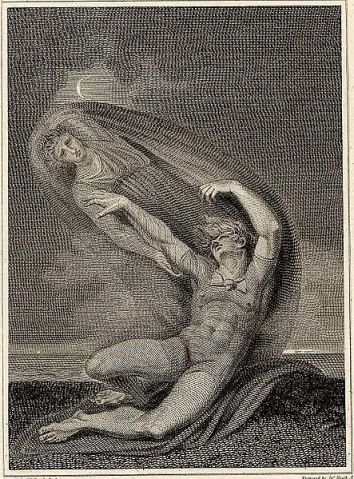
Born to Menoetius, Patroclus didn’t boast a divine lineage like many of his contemporaries. Yet, his life was deeply intertwined with those of demigods and heroes. From an early age, he was fostered by Achilles’ father, Peleus, which led to the inseparable bond between him and Achilles.
There isn’t much known about his birth or early childhood, but legends suggest that he was exiled from his homeland for accidentally killing a boy in a fit of rage. This event brought him to the court of Peleus, where he grew up alongside Achilles, forming a bond deeper than brotherhood.
While Patroclus had no notable romantic tales like Paris or Helen, his relationship with Achilles was profound. Their bond was so deep that some ancient texts hint at a romantic connection, though interpretations vary. Additionally, his interactions with figures like Briseis played pivotal roles in the unfolding of the Trojan War, especially concerning the rift between Achilles and Agamemnon.
Myths about Patroclus
Early Life: The Tragedy in Opus
Before his famed association with Achilles and the events of the Trojan War, Patroclus had a life marked by both privilege and tragedy. Hailing from Opus, the vibrant capital of Locris, he was not always the loyal companion by Achilles’ side. In his younger days, a seemingly innocent game of dice took a dark turn. Engaged in the game with a boy named Clysonymus, a heated moment led to Patroclus accidentally taking the boy’s life.
This grievous act, a stark contrast to the loyalty and compassion he would later be known for, cast a shadow over his reputation. The weight of the crime and the subsequent societal judgment forced him into exile from his homeland. Seeking refuge and a chance at redemption, he found himself in the court of Peleus, Achilles’ father, in Phthia. It was in this new environment, away from the haunting memories of Opus, that the bonds of one of the most iconic friendships in Greek mythology began to form.
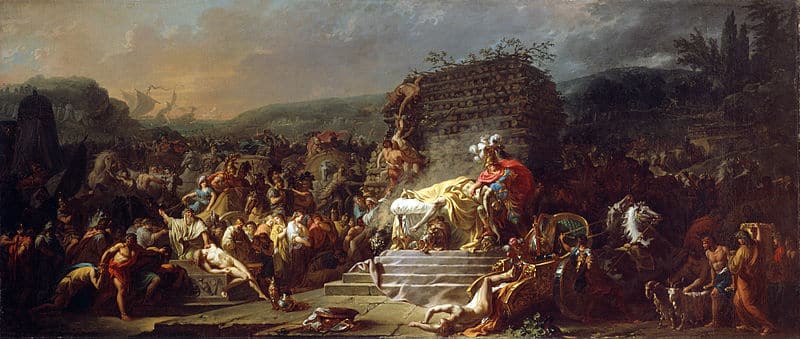
The Quarrel over Briseis
One of the most defining moments in Patroclus’ life revolves around Briseis. When Agamemnon was compelled to return his war prize, Chryseis, to her father, he demanded Briseis, Achilles’ prize, as compensation. This act deeply wounded Achilles’ pride, leading him to withdraw from the war. In his absence, Patroclus, ever the loyal friend, donned Achilles’ armor to rally the Greeks. This act, though brave, would lead to dire consequences.
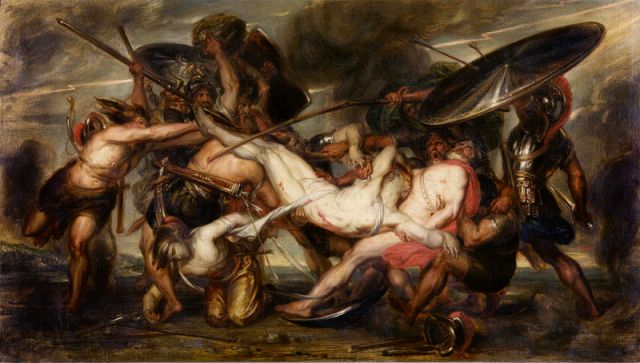
The sight of “Achilles” on the battlefield initially boosted Greek morale. However, Patroclus, carried away by the heat of battle, approached the walls of Troy, a move that Achilles had specifically warned against. It was here that Hector, the Trojan prince, confronted and killed him, mistaking him for Achilles.
The death of Patroclus was a turning point in the Trojan War. Consumed by grief and rage, Achilles returned to the battlefield, seeking vengeance against Hector. In turn leading to one of the most epic duels in mythology.
Depiction And Characteristics
Patroclus, in most depictions, is shown as a young warrior, often alongside Achilles. While not possessing the divine beauty of Achilles, he was nonetheless portrayed as handsome, with a physique befitting a warrior. His armor, especially in the context of his final battle, is a significant symbol, representing both his bravery and fate.
Animals or specific symbols aren’t commonly associated with Patroclus. However, his character is emblematic of loyalty, bravery, and the tragic cost of war. In myths, he’s often the voice of reason to Achilles’ fiery temperament, showcasing a maturity and wisdom beyond his years.
His personality, as gleaned from ancient texts, paints a picture of a compassionate and loyal individual. He cared deeply for the Greek soldiers, which is evident from his plea to Achilles to return to the war or let him don the armor to boost their morale.
The armor itself, a gift from the gods to Achilles, became synonymous with Patroclus’ tragic end. It symbolized both his valor and the immense shadow cast by Achilles, under which Patroclus lived and ultimately died.
Representations Of Patroclus In Art
Throughout the ages, the tale of Patroclus and Achilles has inspired countless artists. From ancient pottery to Renaissance paintings depicting the tragic moment of Patroclus’ death, the visual arts have immortalized their bond.
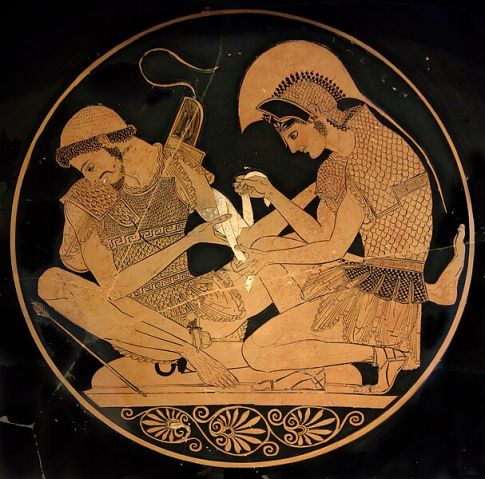
One of the most poignant depictions is found in the Sosias Cup, an ancient Greek kylix, where Achilles is shown tending to Patroclus’ wound. This piece not only showcases their bond but also foreshadows the tragic events to come.
In modern times, the duo has been the subject of sculptures, with artists capturing the raw emotion of their tales. Whether it’s the grief-stricken face of Achilles holding the lifeless body of his comrade or the duo in happier times, their story has been a muse for artists across generations.
Mentions in Ancient Texts
Patroclus’ legacy is deeply embedded in the annals of ancient literature, with the most significant account being in Homer’s “Iliad.” This epic poem, a cornerstone of ancient Greek literature, doesn’t merely mention Patroclus. Instead it intricately weaves his character into the narrative, making him central to the unfolding drama of the Trojan War.
Homer’s “Iliad”
Penned around the 8th century BC, the “Iliad” offers a rich tapestry of heroes, gods, and battles. Within its verses, Patroclus emerges as more than Achilles’ confidant; he becomes the emotional core of the story, especially in the later books. His decision to enter the battlefield wearing Achilles’ armor, his subsequent death at the hands of Hector, and the profound impact this has on Achilles are some of the most poignant moments in the epic.
Homer’s portrayal of Patroclus is filled with depth and emotion. One of the most touching moments is when Patroclus, witnessing the suffering of the Greeks, pleads with Achilles: “Send me out in your place with the rest of the Myrmidons, if only to defend the ships. Let me wear your armor; the Trojans might think you’ve returned to the fight, and the Greeks could catch their breath.”
This plea not only underscores his concern for his fellow Greeks but also foreshadows the tragic events that would follow.
After his death, Achilles’ lament is heart-wrenching, capturing the depth of their bond: “Sleeping in death, Patroclus, I now mourn you. All that I promised once, I now perform: I said I’d drag Hector here and throw him to the dogs of war; your body I’d send back to Achaea, where the sons and daughters of the Achaians would give you a hero’s funeral.”
Through the “Iliad,” Patroclus is immortalized not just as a warrior but as a symbol of both friendship and loyalty. He also symbolizes the devastating personal costs of war.
Frequently Asked Questions
Hector, the Trojan prince, killed Patroclus during the Trojan War, mistaking him for Achilles.
To boost the morale of the Greek soldiers and rally them in Achilles’ absence.
Consumed by grief and rage, Achilles sought vengeance and returned to the battlefield to confront Hector.
No, they weren’t blood relatives but shared a deep bond, often described as closer than brothers.
The quarrel over Briseis between Achilles and Agamemnon led to Achilles’ withdrawal from the war. Setting the stage for Patroclus’ tragic end.
Featured Image Credit: ArchaiOptix, CC BY-SA 4.0, via Wikimedia Commons


